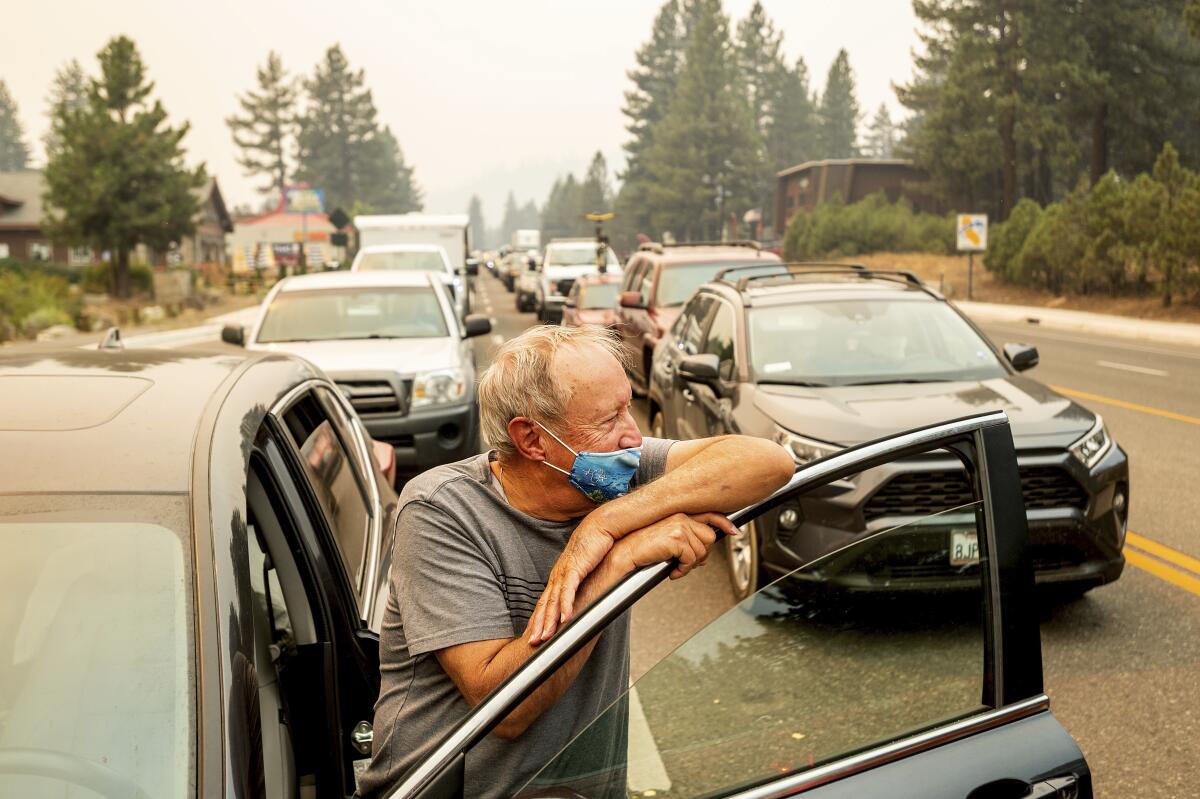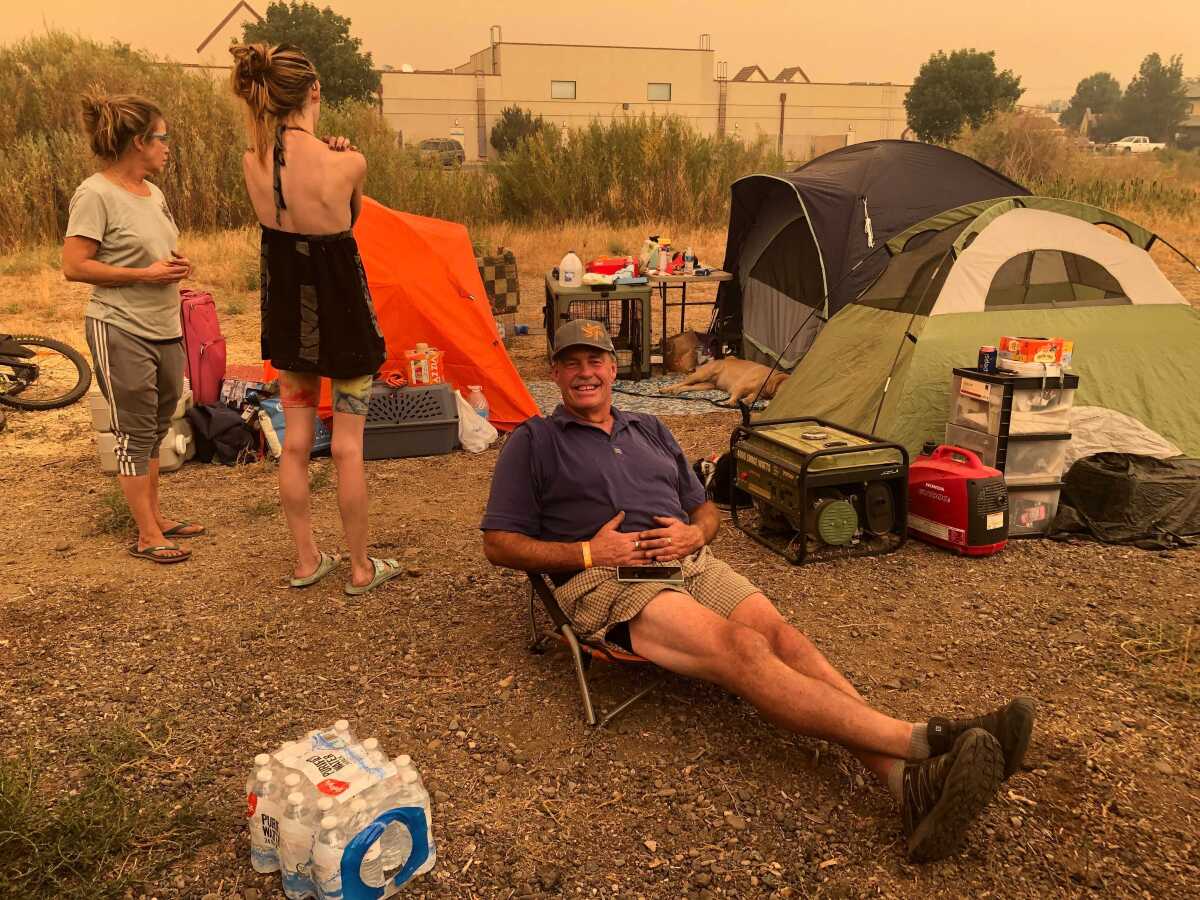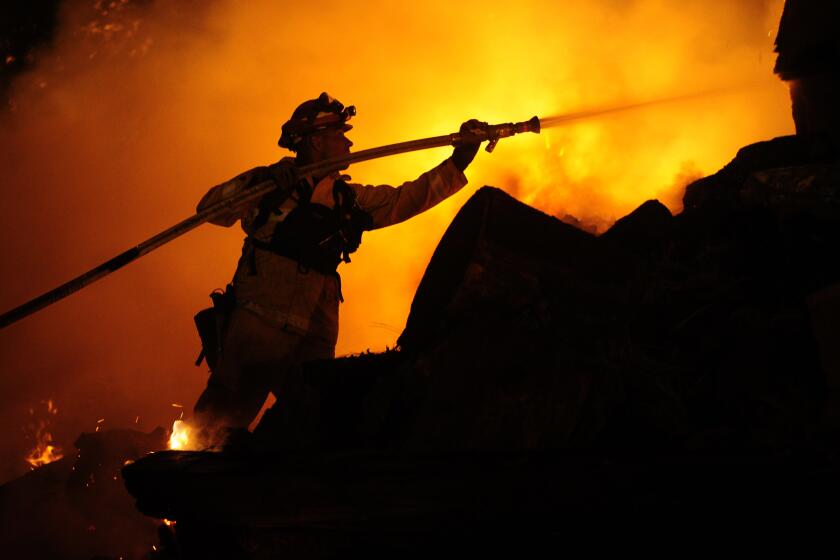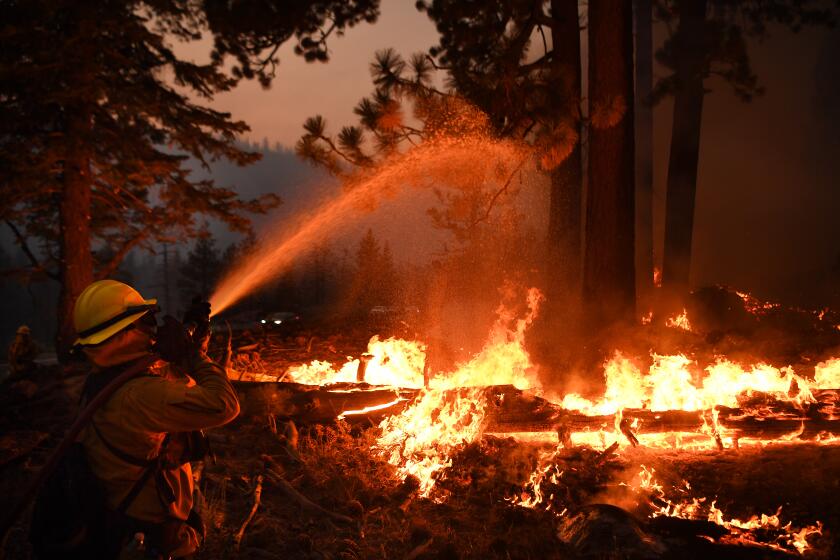Evacuation orders issued in Nevada as Caldor fire moves toward Lake Tahoe

- Share via
GARDNERVILLE, Nev. — While the Caldor fire continues to threaten South Lake Tahoe, it is also taking aim at Nevada, prompting new evacuation orders Tuesday afternoon.
Nevada Gov. Steve Sisolak on Monday declared a state of emergency “in the anticipation of the fire crossing from California into the state of Nevada in the coming days,” his office said.
“We are asking residents to say vigilant, pay attention to emergency phone alerts and have a plan in place for potential evacuations,” officials said.
By late Tuesday afternoon, new evacuation orders came through for the mountain areas just past the state line, including Kingsbury at the top of Daggett Summit. There, half a dozen sheriffs deputies in safety vests began a door-to-door notification as most residents packed their cars and headed out.
Ryan Guest was filling his red Toyota 4Runner with clothes in garbage bags and bins. He returned from Cabo San Lucas only a few weeks ago but is now heading back on the road to San Diego, where he has family.
“It’s not worth it,” he said of the risk of staying.
The Caldor fire is moving toward Nevada, prompting evacuations, while firefighters in the South Lake Tahoe area try to “herd” flames away from homes and structures.
Many residents from Tahoe and nearby areas had already piled into the evacuation center at Douglas County Community Center in Gardnerville, Nev., not far from the state line. Ash fell from a yellow sky Tuesday and blanketed the parking lot.
It fell on the dozens of cars and RVs owned by nearby residents who were forced to evacuate their homes as the Caldor fire approached the Lake Tahoe Basin and threatened to move east.
Standing near three tents set up at the edge of the evacuation center’s parking lot, Rick and Lee Wright, who are ski instructors at Heavenly Mountain Resort, said they had never been evacuated from their home before.
“I didn’t think it could happen,” Rick Wright, 60, said. “I thought they would throw an army in there to stop it from getting to Tahoe, but it became real Sunday night, you know?”
For days the Caldor fire had been moving toward the popular ski resort town. Black smoke billowed out of the fire as it burned acres of forest trees. Wright said it was “dead calm” on Sunday night. There were no winds, just smoke. Then came the evacuation warning.

The Wrights, whose home is two miles southeast of South Lake Tahoe, began loading clothes, photos and documents into a red Ford Expedition and a blue Subaru. Several days before, Wright said, he had packed up two other cars they owned and driven them down to a friend’s house as a precaution.
“We were ready to go anytime,” he said. It was around 10:30 p.m. when a police officer knocked on their door, telling them that there was an evacuation warning but urging them to leave.
“The mandatory evacuation order is coming quickly,” Wright recalled the officer saying.
Concern for his nervous wife and granddaughter, 2-year-old Wynn, he decided to evacuate. It was about 1:30 a.m. when they began to make the 45-minute drive down the mountain to the evacuation center in Nevada. On the way down he tried to keep his wife calm.
“I just told her we were out,” he said. “ I said, ‘We got the baby, we’re good.’”
At the evacuation center, Wright began to set up the tents, which he had bought five months ago to go camping.
“We’re doing it now,” he said, chuckling. “We’re camping.”
A wildfire in South Lake Tahoe would not only threaten lives and homes; it would also move faster, burn hotter and be significantly harder to fight, experts say.
Late Tuesday afternoon, the Douglas County Sheriff’s Office ordered the following communities to evacuate immediately:
- Upper Kingsbury (North and South)
- Central Kingsbury
- Lower Kingsbury
- Round Hills region and roads including Lower Elks Point
- Lake Village
- Lower Olivers, Kahle Drive region and roads
The evacuation warning also includes areas from Highway 50 at Lake Parkway, east to Elks Point Road; and State Route 207 from Highway 50 to Tramway Drive.
In response to the rapidly changing situation, the Nevada Department of Transportation is also closing the following roads, although residents and employees who must enter the area to access their home or work will be allowed to do so, officials said:
- Highway 50 westbound into the Tahoe Basin at Spooner Junction
- State Route 207 westbound at Foothill Road
- State Route 28 and Highway 50 Junction westbound
“On behalf of the state of Nevada, I would like to thank all of our brave first responders, local government agencies, and nonprofit entities who continue to go above and beyond to assist our communities during the Caldor fire,” Sisolak said in a statement. “We will continue to use all our available resources to fight this fire and assist those in need.”
Southern portions of the Lake Tahoe Basin in California were evacuated Monday as the fire crept closer to the famed resort area. Thousands of residents fled, creating an hours-long traffic jam along Highway 50.
The fire is being driven by high winds, with red flag warnings indicating the potential for strong gusts through at least Wednesday evening. Fire officials said they are very concerned that airborne embers could quickly ignite spot fires beyond the lines of the fire.
“We do have very active fire behavior, spotting and torching and very dry fuels under these drought conditions” said Capt. Brian Newman of the California Department of Forestry and Fire Protection. “We expect this active firefight to continue over the next couple days under this current weather condition.”
Thousands rushed to leave South Lake Tahoe as the resort city came under an evacuation order due to the Caldor fire.
At the evacuation center, Phoenix Hunter, 53, a ski instructor, said she began to worry about the fire when she learned that the ski resort she works for, Sierra-at-Tahoe, had called in a hotshot crew to protect the property.
“I had my antenna up,” she said, smiling. She said the resort used snow guns to spray water on the property. Reports emerged Monday that some of its buildings were in flames.
Hunter got an evacuation warning Sunday night and began to place personal items into her Subaru. It was late Monday morning when she began to leave her home with her 15-year-old daughter, two dogs and a rabbit named Butterscotch.
“I was about to leave the house when the [mandatory evacuation order] came in,” she said.
For Hunter and her daughter, it was the second time they had to evacuate. In 2007, the Angora fire forced her to evacuate her home. Her daughter was 1 at the time. Hunter said that she left behind a dog then but that this time she felt more prepared and calm. Still she can’t help but feel some stress.
“I try to look at the bright side that I’m alive and not in the bull’s-eye of the fire,” she said. “I’m sad that some people are, but I try to help others as much as I can.”
“Things could always be worse,” she said.
More to Read
Sign up for Essential California
The most important California stories and recommendations in your inbox every morning.
You may occasionally receive promotional content from the Los Angeles Times.














